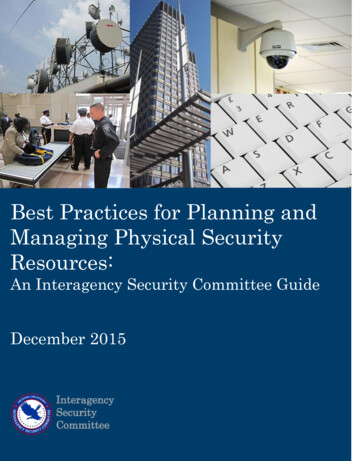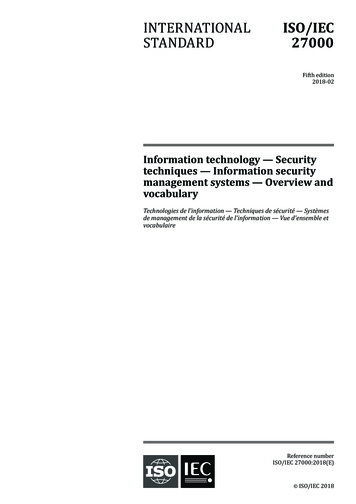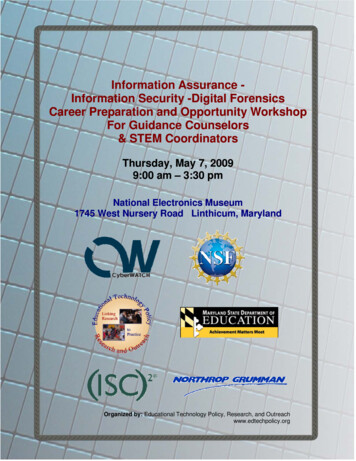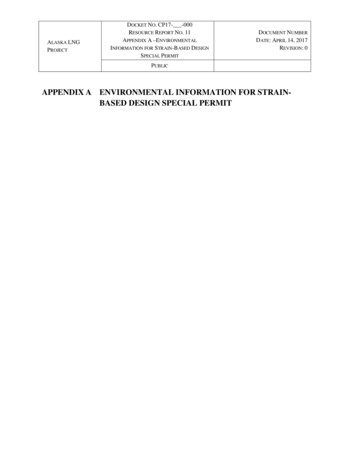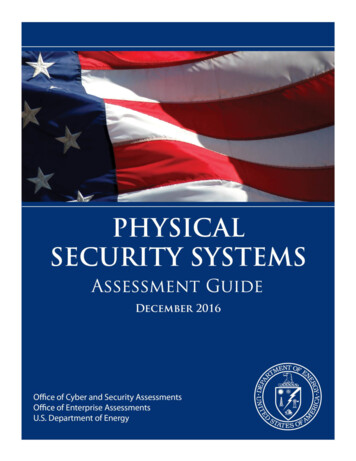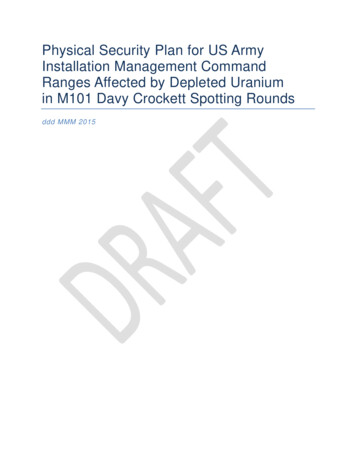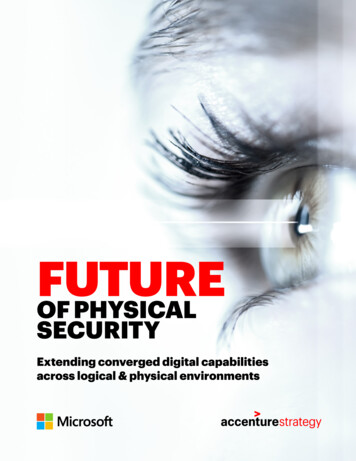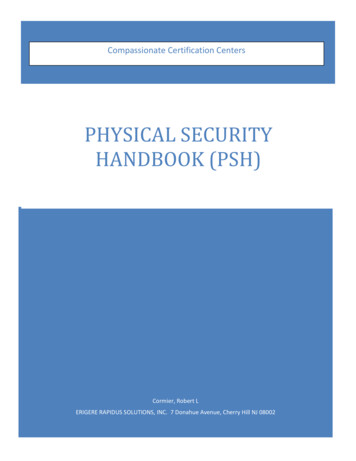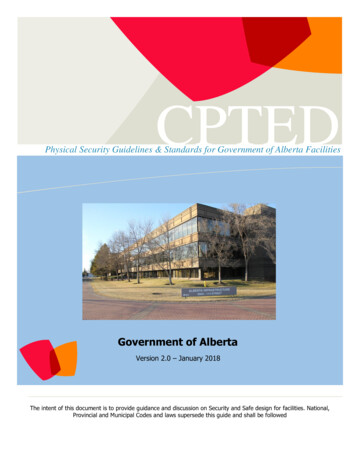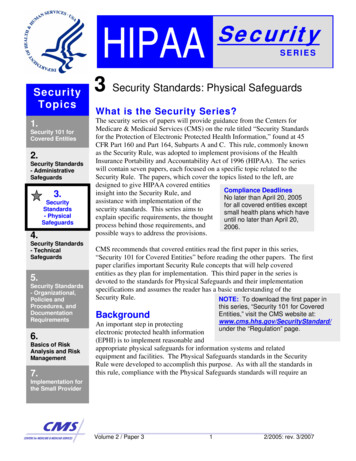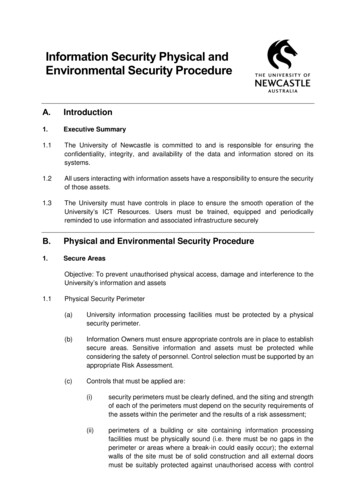
Transcription
Information Security Physical andEnvironmental Security ProcedureA.Introduction1.Executive Summary1.1The University of Newcastle is committed to and is responsible for ensuring theconfidentiality, integrity, and availability of the data and information stored on itssystems.1.2All users interacting with information assets have a responsibility to ensure the securityof those assets.1.3The University must have controls in place to ensure the smooth operation of theUniversity’s ICT Resources. Users must be trained, equipped and periodicallyreminded to use information and associated infrastructure securelyB.Physical and Environmental Security Procedure1.Secure AreasObjective: To prevent unauthorised physical access, damage and interference to theUniversity’s information and assets1.1Physical Security Perimeter(a)University information processing facilities must be protected by a physicalsecurity perimeter.(b)Information Owners must ensure appropriate controls are in place to establishsecure areas. Sensitive information and assets must be protected whileconsidering the safety of personnel. Control selection must be supported by anappropriate Risk Assessment.(c)Controls that must be applied are:(i)security perimeters must be clearly defined, and the siting and strengthof each of the perimeters must depend on the security requirements ofthe assets within the perimeter and the results of a risk assessment;(ii)perimeters of a building or site containing information processingfacilities must be physically sound (i.e. there must be no gaps in theperimeter or areas where a break-in could easily occur); the externalwalls of the site must be of solid construction and all external doorsmust be suitably protected against unauthorised access with control
mechanisms, e.g. bars, alarms, locks, etc.; doors and windows must belocked when unattended and external protection must be consideredfor windows, particularly at ground level;1.2(iii)a manned reception area or other means to control physical access tothe site or building must be in place; access to sites and buildings mustbe restricted to authorised personnel only;(iv)physical barriers must, where applicable, be built to preventunauthorised physical access and environmental contamination;(v)all fire doors on a security perimeter must be alarmed, monitored, andtested in conjunction with the walls to establish the required level ofresistance in accordance to suitable regional, national, andinternational standards;(vi)suitable intruder detection systems must be installed to national,regional or international standards and regularly tested to cover allexternal doors and accessible windows; unoccupied areas must bealarmed at all times; cover must also be provided for other areas, e.g.computer room or communications rooms.(d)A secure area may be a lockable office, or several rooms surrounded by acontinuous internal physical security barrier. Additional barriers and perimetersto control physical access may be needed between areas with different securityrequirements inside the security perimeter.(e)Special consideration must be given towards physical access security whenthe facility houses multiple organisations or business unitsPhysical Entry Controls(a)Secure areas must be protected by appropriate entry controls to ensure thatonly authorised personnel are allowed access.(b)The following controls must be implemented:(i)access to areas where sensitive information is processed or storedmust be restricted to authorised personnel only;(ii)authentication controls, e.g. access control card system, must be usedto authorise and validate such access;(iii)an audit trail of all access must be maintained;(iv)visitors must be escorted by authorised personnel;(v)visitors must only be allowed access for specific and authorisedpurposes;(vi)the date and time of entry and departure of visitors must be recorded;
1.3(vii)all employees and other authorised personnel must wear visibleidentification;(viii)visitors must be issued badges or tags of a different colour thanemployees;(ix)employees must notify security personnel when they encounterunescorted visitors or anyone not wearing visible identification;(x)third-party support personnel may be granted restricted access onlywhen required; their access must be authorised and monitored; and(xi)access rights must be regularly reviewedSecuring Offices, Rooms and Facilities(a)Controls to ensure security of information and information systems located inUniversity offices, rooms and other facilities must be designed, applied anddocumented.(b)Information Owners and IT Security Officers must regularly assess the securityof areas where sensitive information is processed and/or stored. Controls thatmay be implemented to reduce associated risks are:(i)physical entry controls described in Section 2.1.2;(ii)ensure sensitive information is stored properly when not in use inaccordance with Section 2.2.9; and(iii)directories that identify the locations of data centres and other areaswhere sensitive information is stored must not be made public1.4Protecting Against External and Environmental Threats1.5Physical protection against natural disasters, malicious attack or accidents must bedesigned and applied.1.6Information Owners, Data Center Managers, IT Security staff, planners and architectsmust incorporate – to the extent possible – physical security controls that protectagainst damage from fire, flood, earthquake, explosion, civil unrest and other forms ofnatural and man-made disaster. Consideration must be given to any security threatspresented by neighbouring premises or streets. In addition to building code and fireregulations:(a)combustible or hazardous materials must be stored at a safe distance from thesecure area;(b)bulk supplies, e.g. stationary, must not be stored in a secure area;(c)backup equipment and backup media must be located at a safe distance toavoid damage from a disaster affecting the main site; and
(d)1.71.8environmental alarm systems, fire suppression and firefighting systems mustbe installedWorking in Secure Areas(a)Additional security controls and procedures must be used by personnel whenworking in secure areas.(b)Information Owners and University IT Security Officers must identify anddocument requirements that apply to personnel who have been authorised towork in secure areas. Authorised personnel must be informed that:(i)sensitive information cannot be discussed in a non-secure area;(ii)sensitive information cannot be disclosed to personnel who do not havea need-to-know;(iii)no type of photographic, smartphone, video, audio or other recordingequipment can be brought into a secure area unless specificallyauthorised;(iv)maintenance staff, cleaners and others who require periodic access tothe secure area must be screened and their names added to an accesslist; and(v)visitors must be authorised, logged and escortedDelivery and Loading Areas(a)Access points such as reception, delivery and loading areas and other pointswhere unauthorised persons may enter the premises must be controlled and, ifpossible, isolated from secure areas or offices to avoid unauthorised access.(b)Information Owners, University IT Security Officers, planners and architectsmust ensure that:(i)access to a delivery and loading area from outside of the building mustbe restricted to identified and authorised personnel;(ii)the delivery and loading area must be designed so that supplies can beunloaded without delivery personnel gaining access to other parts ofthe building;(iii)the external doors of a delivery and loading area must be secured whenthe internal doors are opened;(iv)loading docks and delivery areas must be regularly inspected andactively monitored;(v)incoming material must be inspected for potential threats before thismaterial is moved from the delivery and loading area to the point of use;
2.(vi)incoming material must be registered in accordance with assetmanagement procedures on entry to the site; and(vii)incoming and outgoing shipments must be physically segregated wherepossibleEquipmentObjective: To prevent loss, damage, theft or compromise of assets andinterruption to the University’s operations2.12.2Equipment Siting and Protection(a)Equipment must be protected to reduce the risks from unauthorised access,environmental threats and hazards.(b)Information Owners, University IT Security Officers, planners and architectsmust ensure that University facilities are designed in a way that safeguardssensitive information and assets.(c)Servers, routers, switches and other centralised computing equipment must belocated in a room with access restricted to only those personnel who require it.(d)Workstations, laptops, digital media and storage devices should be located andused in an area that is not accessible to the public.(e)Equipment must be located, and monitors angled, in such a way thatunauthorised persons cannot observe the display.(f)Shared printers, scanners, copiers and fax machines should not be located inan area that is accessible to the public.(g)Kiosks and other devices that are intended for public use must be clearlylabelled and placed in a publicly accessible areaSupporting Utilities(a)Equipment must be protected from power supply interruption and otherdisruptions caused by failures in supporting utilities.(b)The following controls must be implemented to help ensure availability of criticalservices.(c)All supporting utilities such as electricity, water supply, sewage,heating/ventilation and air conditioning must be adequate for the systems theyare supporting. Support utilities must be regularly inspected and as appropriatetested to ensure their proper functioning and to reduce any risk from theirmalfunction or failure. A suitable electrical supply must be provided thatconforms to the equipment manufacturer’s specifications.(d)An uninterruptible power supply (UPS) to support orderly close down orcontinuous running is recommended for equipment supporting critical businessoperations. Power contingency plans must cover the action to be taken on
failure of the UPS. A back-up generator must be considered if processing isrequired to continue in case of a prolonged power failure. An adequate supplyof fuel must be available to ensure that the generator can perform for aprolonged period. UPS equipment and generators must be regularly checkedto ensure it has adequate capacity and is tested in accordance with themanufacturer’s recommendations. In addition, consideration could be given tousing multiple power sources or, if the site is large, a separate powersubstation.2.3(e)Emergency power off switches must be located near emergency exits inequipment rooms to facilitate rapid power down in case of an emergency.Emergency lighting must be provided in case of main power failure.(f)The water supply must be stable and adequate to supply air conditioning,humidification equipment and fire suppression systems (where used).Malfunctions in the water supply system may damage equipment or preventfire suppression from acting effectively. An alarm system to detect malfunctionsin the supporting utilities must be evaluated and installed if required.(g)Telecommunications equipment must be connected to the utility provider by atleast two diverse routes to prevent failure in one connection path removingvoice services. Voice services must be adequate to meet local legalrequirements for emergency communicationsCabling Security(a)Power and telecommunications cabling carrying data or supporting informationservices must be protected from interception or damage.(b)Power and telecommunications lines into information processing facilities mustbe underground, where possible, or subject to adequate alternative protection.(c)When identified in a Risk Assessment, network cabling must be protected fromunauthorised interception or damage by using a conduit and by avoiding routesthrough public areas.(d)Power cables should be segregated from communications cables to preventinterference.(e)Cables and equipment must be clearly marked to minimise handling errorssuch as accidental patching of wrong network cables. A documented patch listmust be used to reduce the possibility of errors.(f)When a Risk Assessment finds a need for more safeguards, consider:(i)installation of rigid conduit and locked rooms or boxes at inspection andtermination points;(ii)use of alternative routings and/or transmission media providingappropriate security;(iii)use of fibre optic cabling;
2.4use of electromagnetic shielding to protect the cables;(v)initiation of technical sweeps and physical inspections for unauthoriseddevices being attached to the cables; and(vi)controlled access to patch panels and cable roomsEquipment Maintenance(a)Equipment must be correctly maintained to help ensure availability and integrityof sensitive information and assets.(b)When equipment is serviced Information Owners must consider the sensitivityof the information it holds and the value of the assets. The following controlsmust be applied:(c)2.5(iv)(i)equipment must be maintained in accordance with the supplier’srecommended schedule and specifications;(ii)only authorised maintenance personnel may carry out repairs andservice equipment;(iii)records must be kept of all suspected faults and all preventive andcorrective maintenance;(iv)maintenance must be scheduled at a time of day that limits interferencewith services or operations;(v)users must be notified before equipment is taken off-line formaintenance.If off-site maintenance is required then the asset must be cleared of all sensitiveinformation. If it’s not possible to de-sensitise assets before sending formaintenance then the University CIO and Information Owner must considerdestruction of the assetRemoval of Assets(a)University-owned equipment, information and software must not be removedfrom University premises without prior authorisation.(b)Information Owners must establish a formal authorisation
1.6 Information Owners, Data Center Managers, IT Security staff, planners and architects must incorporate – to the extent possible – physical security controls that protect against damage from fire, flood, earthquake, explosion, civil unrest and other forms of natural and man-made disaster. Consideration must be given to any security threats presented by neighbouring premises or streets .
